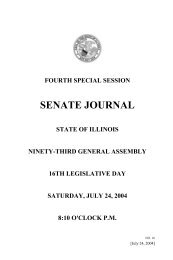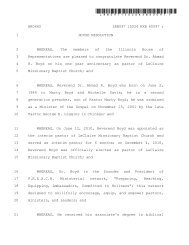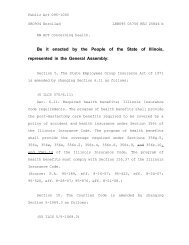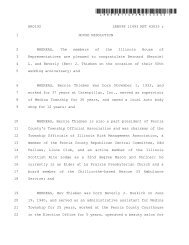Long-Term Care - Illinois General Assembly
Long-Term Care - Illinois General Assembly
Long-Term Care - Illinois General Assembly
Create successful ePaper yourself
Turn your PDF publications into a flip-book with our unique Google optimized e-Paper software.
The <strong>Illinois</strong> Medicaid program, in partnership with other agencies (the Departments of Human<br />
Services and Aging) has a variety of home and community-based programs. Over 51,000<br />
seniors and persons with disabilities are served in these alternative settings. That's 51,000<br />
Medicaid individuals. Several of the programs, such as the Community <strong>Care</strong> Program, also<br />
provide services for non-Medicaid individuals. That translates to about half-and-half,<br />
considering the 56,000 people being in nursing homes and 51,000 individuals being in<br />
community settings.<br />
The department has in the last few years instituted an innovative program known as the<br />
Supportive Living Program — a form of assisted living. It helps seniors have one more option.<br />
There are currently 29 supportive living facilities in operation, and another 41 sites under<br />
development. This type of care promotes personal choice, dignity, privacy and individuality for<br />
residents who use that service.<br />
<strong>Illinois</strong> took advantage a few years ago of a waiver that the Federal government allowed for<br />
implementation of the Senior <strong>Care</strong> (Rx) Program, which allows us to provide comprehensive<br />
drug coverage to <strong>Illinois</strong> seniors up to 200% of poverty. The Governor would like expand<br />
eligibility to people with incomes up to 250% of the federal poverty level. <strong>Illinois</strong> has applied for<br />
this expansion with the Federal government, but it has not yet been approved.<br />
The Senior <strong>Care</strong> (Rx) Program is a very comprehensive drug benefit. Compared to prescription<br />
drug proposals under consideration at the federal level for Medicare, it is a much more<br />
generous program. There is no enrollment fee. There is no deductible. There is $1 co-pay for<br />
generic drugs and $4 for brand names, up to a level of spending of $1,750. After that threshold<br />
is reached there is 20% co-pay. It is a very generous program.<br />
Marta Sayeed<br />
<strong>Illinois</strong> Department of Human Services<br />
The Home Services Program is housed in the Office of Rehabilitation Services within the<br />
Department of Human Services. The program is required to serve people who have disabilities<br />
between the ages of birth to 59, to help prevent institutionalization and, in many instances,<br />
come out of a nursing home. The goal is to provide community services. This is a Medicaid<br />
waiver program.<br />
The Home Services Program began in 1979 as a very small program at the Department of<br />
Public Aid. It was transferred to the then Department of Rehabilitation Services. It was a very<br />
small program. We served 1,200 people. In the early 1980s, the Medicaid waiver was<br />
obtained, and the caseload has grown to 27,000 by the end of this year.<br />
Since the program’s inception, it has been based on the concept of customer choice. The<br />
majority receive home services, but given by personal care attendants. Those attendants are<br />
chosen by the customer, which means they are hired, trained, directed, and, if it doesn't work<br />
out, fired by the individual customer. It puts control of the services with the recipient.<br />
One of the advantages of being in the Department of Human Services, together with the rest of<br />
a number of disability services, is that customers also have direct access to other services,<br />
including the vocational rehabilitation program that relates to some of the same customers. This<br />
39
















